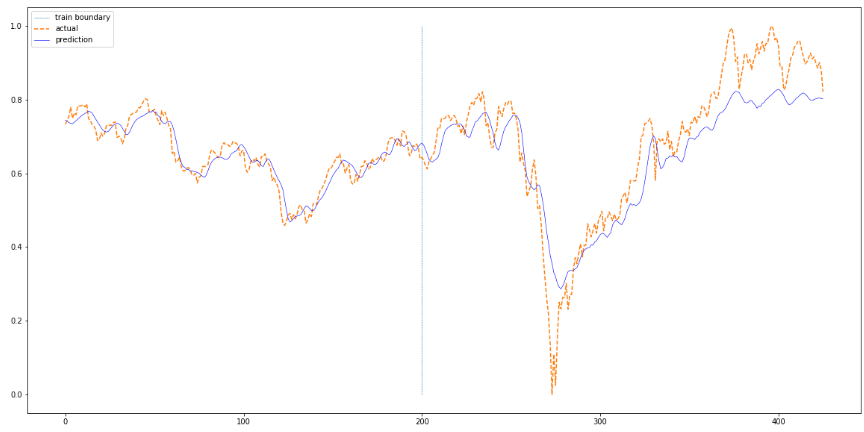파이토치
[파이토치] RNN
알 수 없는 사용자
2022. 2. 14. 13:32
Recurrent Neural Networks
- As you are reading the present sentence, you are processing it word by word while keeping memories of what came before.
- A recurrent neural network (RNN) processes sequences by iterating through the sequence elements and maintaining a state containing information relative to what it has seen so far.
- The network internally loops over sequence elements.

scaler = MinMaxScaler()
df[['Open','High','Low','Close','Volume']] = scaler.fit_transform(df[['Open','High','Low','Close','Volume']])
df[['Open','High','Low','Close','Volume']] = scaler.fit_transform(df[['Open','High','Low','Close','Volume']])
# CPU/GPU
device = torch.device("cuda:0" if torch.cuda.is_available() else "cpu")
print(f'{device} is available.')
# Dataset
X = df[['Open','High','Low','Volume']].values
y = df['Close'].values
# Sequence를 생성하는 함수
def seq_data(x, y, sequence_length):
def seq_data(x, y, sequence_length):
x_seq = []
y_seq = []
for i in range(len(x)-sequence_length):
x_seq.append(x[i:i+sequence_length]) # a[2:6] -> 2,3,4,5
y_seq.append(y[i+sequence_length]) # 지난 5일을 통해서 다음날의 종가를 구한다.
return torch.FloatTensor(x_seq).to(device), torch.FloatTensor(y_seq).to(device).view([-1, 1])
split = 200
sequence_length = 5
x_seq, y_seq = seq_data(X, y, sequence_length)
x_train_seq = x_seq[:split]
y_train_seq = y_seq[:split]
x_test_seq = x_seq[split:]
y_test_seq = y_seq[split:]
print(x_train_seq.size(), y_train_seq.size())
print(x_test_seq.size(), y_test_seq.size())
train = torch.utils.data.TensorDataset(x_train_seq, y_train_seq)
test = torch.utils.data.TensorDataset(x_test_seq, y_test_seq)
batch_size = 20
train_loader = torch.utils.data.DataLoader(dataset=train, batch_size=batch_size, shuffle=False)
test_loader = torch.utils.data.DataLoader(dataset=test, batch_size=batch_size, shuffle=False)
# RNN hyper-parameter
input_size = x_seq.size(2)
num_layers = 2 # 크기가 과도하게 클경우 overfitting 가능성이 커짐
hidden_size = 8 # 크기가 과도하게 클경우 overfitting 가능성이 커짐
input_size = x_seq.size(2)
num_layers = 2 # 크기가 과도하게 클경우 overfitting 가능성이 커짐
hidden_size = 8 # 크기가 과도하게 클경우 overfitting 가능성이 커짐
class VanillaRNN(nn.Module):
def __init__(self, input_size, hidden_size, sequence_length, num_layers, device):
super(VanillaRNN, self).__init__()
self.device =device
self.hidden_size = hidden_size
self.num_layers = num_layers
self.rnn = nn.RNN(input_size, hidden_size, num_layers, batch_first=True) # pytorch에서 제공하는 RNN은 sequence length가 먼저 들어와야하는데, batch_size가 첫번째로 들어왔다. 따라서 순서를 바꾸어하므로, batch_first=True로 선언한다.
self.fc = nn.Sequential(nn.Linear(hidden_size*sequence_length, 1), nn.Sigmoid())
def forward(self, x):
h0 = torch.zeros(self.num_layers, x.size()[0], self.hidden_size).to(self.device) # 초기 hidden state 설정
out, _ = self.rnn(x, h0) # out: RNN의 마지막 레이어로 부터 나온 output feature 반환, hn: hidden state 반환
out = out.reshape(out.shape[0], -1) # many to many 전략. 각각의 일자에 대해서 output도출한다.
out = self.fc(out)
return out
model = VanillaRNN(input_size=input_size,
hidden_size=hidden_size,
sequence_length=sequence_length,
num_layers=num_layers,
device=device).to(device)
criterion = nn.MSELoss()
lr = 1e-3
num_epochs = 200
optimizer = optim.Adam(model.parameters(), lr=lr)
loss_graph = []
n = len(train_loader)
for epoch in range(num_epochs):
running_loss = 0.0
for data in train_loader:
seq, target = data # 배치 데이터
out = model(seq)
loss = criterion(out, target)
optimizer.zero_grad()
loss.backward()
optimizer.step()
running_loss += loss.item()
loss_graph.append(running_loss/n)
if epoch % 100 == 0:
print('[epoch: %d] loss: %.4f' %(epoch, running_loss/n))
# 실제값과 예측값 비교
def plotting(train_loader, test_loader, actual):
def plotting(train_loader, test_loader, actual):
with torch.no_grad():
train_pred = []
test_pred = []
for data in train_loader:
seq, target = data # 배치 데이터
#print(seq.size())
out = model(seq)
train_pred += out.cpu().numpy().tolist()
for data in test_loader:
seq, target = data # 배치 데이터
#print(seq.size())
out = model(seq)
test_pred += out.cpu().numpy().tolist()
total = train_pred+test_pred
plt.figure(figsize=(20,10))
plt.plot(np.ones(100)*len(train_pred),np.linspace(0,1,100),'--', linewidth=0.6)
plt.plot(actual,'--')
plt.plot(total,'b', linewidth=0.6)
plt.legend(['train boundary','actual','prediction'])
plt.show()
plotting(train_loader, test_loader, df['Close'][sequence_length:].values)
